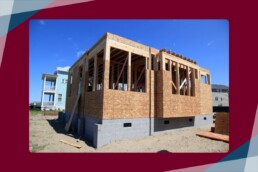Why Are Construction Costs Rising?
The sticker shock is real! If you’re a potential homeowner or a builder, be prepared for prices that are figuratively through the roof.
But what is causing these rising construction costs? There are plenty of reasons, and that’s the problem. It’s not just materials, or labor costs, or the impact of a pandemic. It’s all this and more hitting at the same time.
Read on as we walk you through what’s going on and help you gauge if these high prices are here to stay.
COVID and Rising Construction Costs
Even as vaccines have created a glimmer of hope and allowed the world to begin opening back up, the effects of this deadly and long-lasting pandemic are going to be felt for years, if not decades. Those long-reaching effects of the pandemic managed to reach into the construction industry and had an adverse effect on prices already.
At the start of the pandemic, when lockdowns were first imposed over much of the country, things just stopped. Streets were empty, buildings were closed, and construction sites all over the U.S. went silent. The result is that projects were postponed, canceled, or placed on hold.
The problem is that while building things went on hiatus, the old law of supply and demand didn’t slow down, and we all know how that works: When there’s no supply, demand shoots up, and that means high prices.
Those rising costs are also going to affect your construction costs, but at the Oliver L. E. Soden Agency, construction insurance is one of our specialties. So if you’re in the construction business and worried about being covered during these price jumps, we’ve got you covered.
New Home Construction
According to the U.S. Census, new home construction continues to lag behind the need for new homes. In May, it was down over 9 percent from the previous month. The Census also reported that there’s only a two-month supply of housing inventory, and the normal range is up to six months.
While these stats can also be tied to COVID-related slowdowns, the practical effect is that there just aren’t enough houses to go around. That’s pushed demand through the roof and the demand is making buying a home a headache of waived inspections and escalation clauses. It’s reminiscent of the housing bubble of 2008, and there are some worries that the market is too hot.
If you’re one of the lucky new homeowners out there, make sure your hard-won new home is well covered. Before you sign anything, come to Oliver L. E. Soden agency to make sure that once you get that house, you keep yourself and everything in it safe.
Materials Costs
Another driver in construction costs is the astronomical cost of lumber. At the beginning of this year lumber futures, a contract where people speculate on the price of wood in the future was about $700 per thousand board feet. By May, it had doubled to around $1400.
The end result is that wood is incredibly expensive right now, and as long as houses are still made of wood, that’s going to add big numbers to a new home that’s already in high demand. Like in so many other industries, the reasons why can be traced back to disruptions in the supply chain back in the early days of COVID.
But while prices have been dropping a bit recently, it’s going to take the lumber industry a while to catch up with the backlog. And it’s not just wood that’s feeling the spike in pricing. Industry watchers are seeing spikes in everything from drywall to appliances.
The steel and metal industry is also in the midst of a price boom. This has a greater impact on retail construction, but if there’s anything in your new home that’s metal—appliances or ductwork, for instance—it’s also going to affect your bottom line costs.
How Long Will This Last?
If you’re thinking about buying a home, updating your current home, or selling what you’ve got, it’s worth thinking about how long the experts say our current state is going to last. Is it worth it to wait out the boom and hope for days when your dream home might be a bit less expensive?
The answer is unclear, but here’s what we do know. Industry watchers say that at the rate the industry is playing catchup, supply and demand don’t look like they’re to even out a bit until well into 2022. So if you’re putting off buying until the market cools down, you’re going to be waiting at least a year.
The same goes for materials. The lumber industry is moving aggressively to respond to increased demand, but new lumber mills don’t build themselves, and like everyone building anything right now, high costs are putting a damper on some new construction.
Any Good News?
But there is some good news for potential buyers. Some analysts say many homes are overvalued by as much as 5 percent in some hot markets. At the same time, employment rates in the wake of COVID are recovering fairly slowly and wages are still stagnant.
That means people don’t have as much money to spend as they did. Industry watchers say that’s going to eventually force prices down.
That downward pressure on pricing will help over the long term, but don’t hold your breath. The fact is that sky-high housing prices and rising construction costs are here to stay for at least the rest of 2021.
What Can I Do?
Whether you’re a builder or a buyer, the fact is the work needs to get done, and you will need a new house despite rising construction costs.
But that doesn’t mean you have to do it alone. At Oliver L. E. Soden Agency, making sure you’re covered and helping you manage risk is what we’re all about.
So before you break ground or sign anything, visit our website or contact us. We’ll be happy to give you a quote or work with you to make sure that what may be the biggest investment in your life is as safe and smart as possible.
Related Articles
Homeowners Insurance in NJ: A Comprehensive Guide
Key Takeaways Homeowners insurance in NJ protects your home, personal property, and liability, making it essential for safeguarding your investment. Annual…
What You Need to Know About Flood Insurance in NJ
Key Takeaways Flood insurance is essential for New Jersey homeowners, even those outside high-risk zones, as flooding can occur anywhere from various sources…


